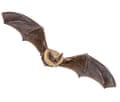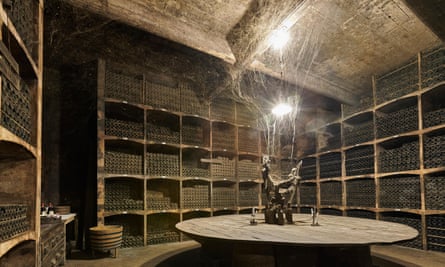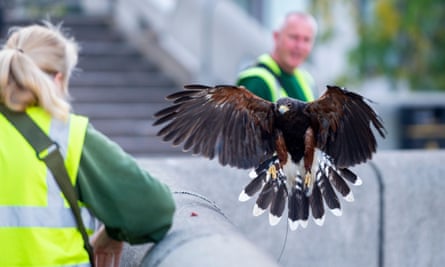Our relationship with animals is a complex tapestry, woven with threads of affection and exploitation, ranging from cherished companions to mere tools of our convenience. While we might pamper our pets, the majority of animals don’t share the same fortune when they encounter humanity.
Yet, amidst this intricate web of interactions, there are remarkable instances where human interests and the natural behaviors of animals harmoniously converge. These partnerships may not always fall under the classic definition of “mutualistic,” where both species benefit equally, like the symbiotic dance between a clownfish and its sea anemone. Nevertheless, they exemplify a heartening give-and-take between us and the animal kingdom.
In this exploration, we embark on a journey to discover the exceptional animals that work for a living, showcasing their unique contributions to society. From ferret electricians to landmine-sniffing rats, these extraordinary creatures redefine the boundaries of interspecies cooperation, demonstrating the remarkable ways in which our world is enriched by their labor. Join us as we unveil these unsung heroes and their roles in forging a mutually beneficial relationship with humanity.
Bat librarians

The world of interspecies collaboration is a fascinating one, with remarkable examples spanning centuries and diverse environments. While we often think of animals toiling in the wild, there are instances where they find a unique niche in our human-made habitats, contributing in surprising ways.
Consider the Joanina Library, a baroque treasure nestled in the University of Coimbra, Portugal. Known for its ornate gilding and woodwork, it’s also home to what the deputy director, António Maia do Amaral, affectionately dubs its “honorary librarians” – bats. Two small colonies, including free-tailed bats and pipistrelles, have taken up residence within the library’s historic walls for generations. It’s believed they serve as guardians, keeping book-eating insects at bay, even if no one has verified this through a droppings analysis.
These winged creatures are part of the library’s charm, occasionally surprising visitors with their graceful flights during evening events. While opinions about their presence have shifted over the years, with some considering them of minimal importance, others, like Amaral, celebrate the bats and their role in this unique ecosystem.
But bats aren’t the only honorary librarians in the history of libraries. Joanina once budgeted for the upkeep of mouse-hunting cats, as documented in historical records. “Cat doors” etched into the woodwork remain as intriguing remnants of this feline partnership, showcasing the ever-evolving relationship between humans and animals.
As we delve deeper into the world of animals at work, we’ll unveil more extraordinary stories of collaboration between different species, each one contributing in its own, often unexpected, way to the intricate tapestry of life on our planet.

Ferrets: The Curious and Nimble Cable Workers
Ferrets, those inquisitive little devils, possess a unique set of qualities that make them invaluable in some rather unconventional job roles. James McKay, from the National Ferret School, aptly describes them as inquisitive, always eager to explore and discover what lies at the other end of any opening. This curiosity, combined with their slender bodies and exceptional flexibility, allows them to access places and perform tasks that would be utterly impossible for humans.
These remarkable creatures have donned various professional hats over the years. In 1971, Felicia the ferret became a furry pipe cleaner for the Fermilab particle accelerator in Illinois. In 1981, ferrets wriggled beneath the floors of St. Paul’s Cathedral, facilitating the transmission of the royal wedding on television. They even played a pivotal role in cabling the Millennium Dome, a trio aptly named Beckham, Posh, and Baby.
So, how do these ferrets accomplish such unique tasks? They wear harnesses attached to long, lightweight nylon lines. Once they’ve threaded the line through a duct, it gets connected to a heavier pull rope, enabling the cable to be passed through. Although some training is involved, it primarily capitalizes on the ferrets’ natural inclination to explore holes. A bit of salmon oil at the far end of a long pipe acts as a reward, guiding them along. Incredibly, these ferrets can travel significant distances, with some covering as much as 250 meters – an impressive feat for their size.
The National Ferret School has a business collective of about 50 ferrets, with McKay usually bringing half a dozen on a job, ensuring there’s always one in the right mood for the task. The males, known as hobs, are often preferred for pulling lines over longer distances, while the smaller females, known as jills, excel in navigating the narrowest spaces. When asked if he has a favorite ferret, McKay diplomatically responds, “They’re all as good as each other.” These furry, curious creatures continue to amaze with their unique abilities and unwavering dedication to their not-so-typical occupations.

At Vergenoegd Löw Winery: Indian Runner Ducks as Nature’s Pest Control
In the picturesque vineyards of Vergenoegd Löw Winery in South Africa, an army of unconventional pest controllers is on duty, and they’re not your typical grape growers. Meet the more than 1,000 Indian runner ducks, often fondly referred to as the vineyard’s “soldiers.” Each morning, they burst forth in a lively cacophony of honks, embarking on their essential mission.
Their task is clear: to safeguard the vineyards from unwanted guests like aphids, snails, and worms. With unwavering dedication, these diligent ducks roam the vineyard’s expanse, ensuring the vines remain pest-free and healthy. They operate in a well-choreographed 14-day cycle, systematically covering different sections of the vineyard. An added perk comes from their droppings, which provide an invaluable natural fertilizer to nurture the vines.
These remarkable vineyard soldiers have their priorities straight but do indulge in a short break during harvest season. The temptation of ripe grapes proves too much to resist, so the ducks enjoy a well-deserved holiday. During this time, they take to a nearby lake for leisurely swims, forage on adjacent farmlands, and, in their own unique way, contribute to the vineyard’s future by participating in the generation of the next cadre of duck “soldiers.”
At Vergenoegd Löw Winery, nature’s approach to pest control not only protects the vines but also enriches the environment, showcasing the harmonious partnership between agriculture and the animal kingdom. These Indian runner ducks have certainly earned their place as the vineyard’s invaluable allies in the quest for producing exceptional wines.

In the heart of La Rioja, at the R López de Heredia winery, a remarkable alliance exists between nature and winemaking tradition. As you venture into the dimly lit cellar, you’ll be greeted by an unusual sight – gigantic cobwebs, not as spooky decor, but as the homes of diligent spiders.
These arachnids are not there for aesthetics; they play a crucial role in safeguarding the winery’s treasures. Their mission: to protect the barrels and corks from the insidious threat of cork-eating moths, known as the “mortal enemy of long-aging wine.” The delicate balance between producing exceptional, aged wines and preserving them for decades relies on this unexpected partnership.
The cobwebs, draping the cellar walls and veiling the bottles, serve as fortresses against the invaders. These eight-legged sentinels intercept and capture the pesky moths, ensuring they never compromise the wine’s quality. It’s a sustainable, natural approach to winemaking, where the winery works in harmony with the environment, rather than resorting to chemical solutions.
At R López de Heredia Winery, the cobwebs are not just a part of the decor – they are a testament to the winemakers’ commitment to their craft and a nod to the intricate balance that can be achieved when nature becomes an integral part of the winemaking process.
Apopo’s Multitalented African Giant Pouched Rats: Heroes of Detection

Within the ranks of the NGO Apopo, there’s an exceptional team of workers – 300 African giant pouched rats – whose talents span across fields as diverse as mine clearance in South-East Asia and Africa, to detecting positive tuberculosis sputum samples. What makes these rats so remarkably proficient in their roles? According to Lily Shallom of Apopo, it’s a combination of intelligence, sociability, and an extraordinary sense of smell.
These rats have an innate ability to detect minute traces of odors, exemplified by their capability to sniff out a picogram of TNT, which is a trillionth of a gram. Their motivation is a simple one: food. They are food-driven creatures with a penchant for items like peanuts and bananas. Moreover, they possess a sweet tooth and an affinity for high-fat, high-protein content. It’s this hunger for rewards that makes them such diligent workers.
In mine clearance operations, the rats don’t trigger explosives due to their minimal weight, which maxes out at 1.5 kilograms. They are trained to signal the presence of a landmine by scratching at the ground’s surface, alerting their human counterparts without risking their own safety.
For tuberculosis detection, the rats exhibit a different but equally remarkable behavior. They hover over potentially positive sputum samples for three seconds, effectively flagging them for further evaluation. This method provides a rapid and reliable means of identifying tuberculosis cases, particularly in regions where conventional testing may be limited.
Apopo’s African giant pouched rats are not just skilled workers; they are unsung heroes in the realms of humanitarian aid and public health. Their intelligence, keen senses, and unwavering dedication to the job make them invaluable assets in addressing critical challenges around the world.
For the African giant pouched rats at Apopo, life is a delightful mix of work and play. These highly sociable creatures, renowned for their remarkable skills, have a daily routine that is as fulfilling as it is unique. Training and work, which can span nine months, occupy just a tiny fraction of their day.
In the world of mine detection, the rats engage in sessions lasting around 20 to 30 minutes, making them incredibly efficient at their task. As for assessing tuberculosis samples, a batch of 100 samples can be processed in a maximum of 20 minutes, a task that might take a human technician up to four days. This impressive speed is a testament to their exceptional abilities.
What truly sets these rats apart is their leisure time. The majority of their day is devoted to activities they thoroughly enjoy. Free play, socializing with fellow rats, satisfying their appetites with snacks, and indulging in well-deserved naps all make up this luxurious portion of their lives.
Apopo, a forward-thinking organization, is continually exploring new avenues for the rats’ special skill set. Beyond their current roles, these remarkable creatures are being considered for projects like searching for survivors in the aftermath of natural disasters, detecting illegally trafficked pangolin scales, and even decontaminating land by identifying specific concentrations of hydrocarbons in soil. These rats are living examples of the harmonious collaboration between humans and animals, where their unique talents are harnessed for the betterment of society and the environment.
The Fascinating Mutualistic Bond Between Humans and Honeyguides

In the heart of Africa, an extraordinary example of mutualism unfolds, where humans and greater honeyguides engage in a collaborative relationship, each benefitting from the other’s unique abilities. This small, brownish African bird, a close relative of the woodpecker, plays a remarkable role as a guide to honey for the humans. The honeyguide, with its keen instinct, flutters in front of people, emitting a distinctive tweet-like sound to lead them to bees’ nests nestled within hollow tree trunks.
Once the humans have been directed to the treasure trove of honey, they take over. They employ their skill in smoking out the potentially dangerous bees, securing the golden prize of honey. Meanwhile, the honeyguide patiently observes and waits for its moment. Its reward, the wax from the bees’ nests, is its preferred delicacy.
What makes this partnership even more remarkable is the discovery that the communication between humans and honeyguides is a two-way street. Research conducted at the University of Cambridge in 2016 revealed that honey hunters from the Yao community in Mozambique have honed a specific sound to attract honeyguides. The unique call, described as “A loud trill followed by a short grunt: brrr-hmm,” significantly increased the chances of a successful interaction. Compared to control sounds, the “brrr-hmm” call raised the overall likelihood of finding honey from 16% to an impressive 54%, ensuring a bountiful harvest for humans and a delectable feast of wax for the birds.
This harmonious relationship between humans and honeyguides is a testament to the extraordinary bonds that can exist in the natural world. It showcases how cooperation between species, even across different branches of the animal kingdom, can lead to mutual benefit, revealing the intricate web of life’s interconnectedness. Dr. Claire Spottiswoode, who led the project, provided a fascinating insight into this captivating partnership that enriches the lives of both humans and honeyguides.
Harris’s Hawks: Urban Avian Enforcers at British Railway Stations
If you’ve spent any time at British railway stations, you may have witnessed an intriguing sight – someone donning a hi-vis tabard, casually strolling with a majestic hawk perched on their wrist. Or perhaps you were lucky enough to witness the awe-inspiring flight of these raptors as they effortlessly glided among the rafters before gracefully returning to their handler’s glove. In all likelihood, you were observing one of Citihawk’s Harris’s hawks, the unsung heroes that help deter pigeons from places like King’s Cross and Victoria in London, as well as numerous other stations, Westminster Cathedral, and even locations as diverse as stadiums and school playing fields.

But why the need to deter pigeons? According to Leigh Holmes of Citihawk, pigeons pose a dual health hazard. Their droppings are rife with bacteria and parasites, and when wet, they become a slippery nuisance. The hawks, however, are not there to attack or dine on pigeons. Instead, they return to their handlers for chicken pieces. The goal is to intimidate the pigeons and discourage them from returning. Holmes explains that the theory is that “pigeons see a natural predator that they are hardwired to fear… They vanish to seek safer roosting, nesting, and feeding grounds.”
The Harris’s hawks enjoy their work, soaring freely and exploring the site of the day. This urban environment with its hustle and bustle seems to be something they relish. Holmes notes, “They really enjoy some of the hustle and bustle because they fly exceptionally well.” Of course, this freedom occasionally leads to them going off track. “They can be quite childlike at times and spot a pigeon a street away or on another roof. They will literally just go to scare off other birds.” To keep tabs on their location, these hawks are fitted with trackers, allowing their handlers to follow their movements in real time.
Harris’s hawks excel at this task due to their natural gregariousness and collaborative hunting instincts. When trained by humans, they perceive their falconer as a vital part of their hunting team. They learn to read each other, forming a remarkable bond between bird and handler.
Beyond their primary role, the falconers often find themselves interacting with delighted members of the public who are amazed by the hawks’ presence. The fascination, the photographs taken, and the genuine love for these birds of prey create a unique experience for both the handlers and the audience. In the world of pest control, these majestic raptors have certainly earned their wings, and they continue to capture the hearts and imaginations of those they encounter.
The PetEarnest carry you the latest news on animals and their surroundings. Comply with The PetEarnest on Google News and subscribe here to our weekly electronic mail!


